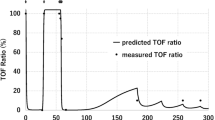Abstract
The dose-response relation of pipecuronium, the time course of its neuromuscular blocking effects, and the reversibility of the residual block by neostigmine have been investigated in patients under sevofluraney N2O Anesthesia using a neuromuscular transmission analyzer (Accelograph®, Biometer, Denmark). After an initial dose of pipecuronium (0.04 mg·kg−1, i.v., the maximum block rate, onset time, the time from administration until 25% recovery and 50% recovery of control twitch height of the first response to train-of-four nerve stimulation and the interval time of administration of maintenance dose (0.005 mg·kg−1, i.v.) were 93.7±7.68%, 5.0±1.84, 55.4 ±23.92,73.0±29.44 and 38.7±15.50 minutes, respectively. The average intubation score (excellent; 0, good; 1 fair; 2, poor; 3) was 0.63±0.56 at the level of 95.88±5.06% block. Neostigmine (1.5 mg) promptly reversed the residual neuromuscular blockade induced by pipecuronium (reversal time: 10.1±2.98 minutes). No side effects attributable to pipecuronium was seen in this study.
In conclusion, pipecuronium is a very useful nondepolarizing neuromuscular blocking agent especially for moderately long surgical procedure over 4–5 hours.
Similar content being viewed by others
References
Agoston S, Wierda JMKH, Swen J: The clinical pharmacology of pipecuronium bromide. Neuromuscular blocking agents: past, present and future, Excepta Medica, Amsterdam, 1990, pp. 137–147
Maestrone E: Pipecuronium, pancuronium and alcuronium; dose-response relationships and clinical profiles. Neuromuscular blocking agents: past, present and future, Excepta Medica Amsterdam, 1990, pp. 148–160
Zwölfer W, Schwarz S, Perger P, et al: Clinical comparison of the cardiovascular effects of pipecuronium bromide and pancuronium bromide in patients undergoing coronary artery bypass graft surgery. Neuromuscular blocking agents: past, present and future, Excepta Medica Amsterdam, 1990, pp. 161–167
Ueda N, Muteki T, Poulsen A, et al: Clinical Assessment of a New Neuromuscular Transmission Monitoring System (ACCELOGRAPH®) — A comparison with the conventional method —. J Anesth 3:90–93, 1989
Fahey MR, Morris RB, Miller RD, et al: Clinical pharmacology of Org NC45. Anesthesiology 55:6–11, 1981
Viby-Mogensen J, Howardy-Hansen P, Chrremmer-Jorgensen B, et al: Posttetanic count (PTC); A new method of evaluating an intense nondepolarizing neuromuscular blockade. Anesthesiology 45:458–461, 1981
Ueda N, Muteki T and Tsuda H: What Anesthesiologist Should Know about Neuromuscular Monitoring Today? J Anesth 6:192–206, 1992
Inoue S, Veda N, Tsuda H, et al: Accelerated Reversal of Pancuronium Blockade with Divided Administration of Neostigmine. J Anesth 3:240–243, 1989
Wierda JMKH, Richardson F J and Agoston S: Dose response relation and time course of pipecuronium bromide in humans anesthetized with nitrous oxide and isoflurane, halothane, or droperidol/fentanyl. Anesth Analg 69:208–213, 1989
Author information
Authors and Affiliations
About this article
Cite this article
Ueda, N., Masuda, Y., Muteki, T. et al. Dose-response relation and time course of. J Anesth 7, 151–156 (1993). https://doi.org/10.1007/s0054030070151
Received:
Accepted:
Issue Date:
DOI: https://doi.org/10.1007/s0054030070151




